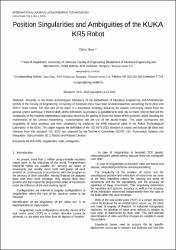Position Singularities and Ambiguities of the KUKA KR5 Robot
Özet
Recently in the Robot technological laboratory of the Department of Electrical Engineering and Mechatronics (EEM) of the Faculty of Engineering, University of Debrecen there have been several researches concerning the KUKA and SONY Scara robots. Various diploma works have already been made in the laboratory and students have informed me that the running of their program was interrupted because of an unknown error. The error could be unanimously led back to the ambiguity of robots. Meanwhile, industrial partners also contacted the laboratory asking for advice to solve similar problems. To solve the aforementioned problem of this two-way inquiry I began to be engaged in the problems of singularities and ambiguities. The first part of the paper is a theoretical summary deducing the notions concerning robots from the general system technique. I tried to draft all the definitions as precisely as possible to be able rely on them, only to find out the complexity of the required mathematical apparatus necessary for getting to know the nature of this problem, albeit knowing the mathematics of the Denavit–Hartenberg transformation and the use of the Jacobi-matrix. This paper summarizes the singularity of robot positions and their uncertainty by analyzing the KR5 industrial robot in the Robot Technological Laboratory in the EEM. This paper regards the definition of the ISO 8373:2012 standard as a base and deduces all ideas and relations from this standard. ISO 8373 was prepared by the Technical Committee ISO/TC 184, Automation Systems and Integration, Subcommittee SC 2, Robots and Robotic Devices.

















